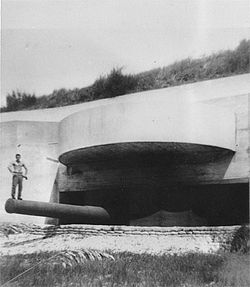Harbor Defenses of New Bedford
[1] It coordinated the coast defenses of New Bedford, Massachusetts and the nearby Cape Cod Canal from 1900 to 1950, beginning with the Endicott program.
A group of about 30 patriots in the 40-ton sloop Success retrieved two vessels that had been captured by HMS Falcon, taking some British prisoners in the action.
[9][10] Another major action in the Revolution was Grey's raid on 5–6 September 1778, in which the Fairhaven fort was destroyed.
A force under Major Israel Fearing drove off the British, both at the fort and when they attempted an attack on the town the next day.
[7] In the War of 1812, HMS Nimrod bombarded Fort Phoenix on 13 June 1814 when the local militia refused to surrender some guns.
Local accounts differ as to whether she launched boats carrying a landing party that were driven off, or not.
[16] After the Civil War began in April 1861, it was apparent that the Fort at Clark's Point was still years from completion.
Fort Taber, a small earthwork with six cannon, was built nearby with city resources and named after New Bedford's mayor during that period.
The Clark's Point area was officially named the Fort Rodman Military Reservation in 1898, in honor of Lieutenant Colonel Logan Rodman, a New Bedford native with the 38th Massachusetts Infantry who died in the assault on Port Hudson, Louisiana in 1863.
Fort Rodman's pair of pedestal-mounted 5-inch guns was transferred to the US Army transport ship USAT Kilpatrick.
[17] A major upgrade began construction at Fort Rodman during the war, Battery Milliken with two 12-inch guns on long-range barbette carriages, initially in open emplacements.
[17] References indicate the authorized strength of CD New Bedford in World War I was five companies, including one from the Rhode Island National Guard.
[4] In 1920 Fort Rodman's M1898 3-inch guns were scrapped as part of a general removal from service of this weapon; they were not replaced.
[1] In 1938 a battery of two 155 mm guns on "Panama mounts" (circular concrete platforms) was built at Fort Rodman, probably due to its complete lack of other medium- and small-caliber artillery.
[17] Early in World War II numerous temporary buildings were again constructed to accommodate the rapid mobilization of men and equipment.
The 242nd was a Connecticut National Guard regiment normally assigned to the Harbor Defenses of Long Island Sound.
[1] Several medium- and small-caliber batteries were built in New Bedford and the Buzzards Bay area during World War II.
A museum and a World War II M4 Sherman tank recovered from the tragic Exercise Tiger are in the park.






